

Providing constructive feedback to students during mentoring. Teaching Skills: Giving Constructive Feedback and Assessment - Careers Advice. One of the most common questions students ask teachers all over the world is ‘what did I get?
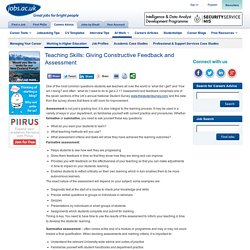
And ‘how am I doing? And often: ‘what do I need to do to get a 2.1? Assessment and feedback comprises one of the seven sections of the UK’s annual National Student Survey www.thestudentsurvey.com/ and the data from the survey shows that there is still room for improvement. Assessment is not just a grading tool; it is also integral to the learning process. It may be used in a variety of ways in your department, so familiarise yourself with current practice and procedures. What do you want your students to learn?
Formative assessment: The exact nature of the assessment will depend on your subject; some examples are: Diagnostic test at the start of a course to check prior knowledge and skillsPrecise verbal questions to groups or individuals in seminarsQuizzesPresentations by individuals or small groups of studentsAssignments which students complete and submit for marking. Timing is key. Teaching and Learning Hub - Assessing learning & providing feedback - How do I make sure my feedback is timely and appropriate? Orientation How do I give good, constructive feedback to students?
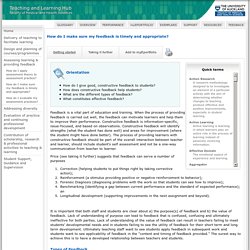
How does constructive feedback help students? What are the different types of feedback? What constitutes effective feedback? Feedback is a vital part of education and training. Price (see taking it further) suggests that feedback can serve a number of purposes Correction (helping students to put things right by taking corrective action);Reinforcement (a stimulus providing positive or negative reinforcement to behavior);Forensic Diagnosis (diagnosing problems with the work so that students can see how to improve);Benchmarking (identifying a gap between current performance and the standard of expected performance); anLongitudinal development (supporting improvements in the next assignment and beyond). Providing Constructive Feedback.
The fundamental question we have to ask in providing feedback is “what are my learner’s needs?”
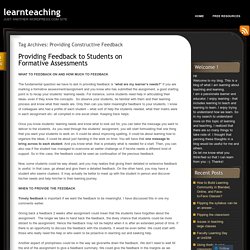
If you are marking a formative assessment/assignment and you know who has submitted the assignment, a good starting point is to recap your students’ learning needs. For instance, some students need help in articulating their ideas- even if they know the concepts. So observe your students, be familiar with them and their learning process and know what their needs are. Only then can you tailor meaningful feedback to your students. I know of colleagues who had a profile of each student – what sort of help the students needed, what their marks were in each assignment etc- all compiled in one excel sheet.
Once you know students’ learning needs and know what to look out for, you can tailor the message you want to deliver to the students. Press Release - Research Paper on Providing Learners with Feedback. For Immediate Release Questionmark Commissions New Work-Learning Research White Paper by Dr.
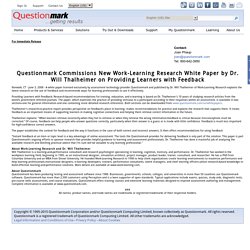
Will Thalheimer on Providing Learners with Feedback. 20 Ways To Provide Effective Feedback For Learning - 20 Ways To Provide Effective Feedback For Learning by Laura Reynolds.
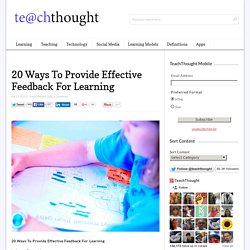
5 Research-Based Tips for Providing Students with Meaningful Feedback. In recent years, research has confirmed what most teachers already knew: providing students with meaningful feedback can greatly enhance learning and improve student achievement.

Professor James Pennebaker from the University of Texas at Austin has been researching the benefits of frequent testing and the feedback it leads to. He explains that in the history of the study of learning, the role of feedback has always been central. When people are trying to learn new skills, they must get some information that tells them whether or not they are doing the right thing.
Learning in the classroom is no exception. Relevant Research: How to Make Feedback Matter. EdSurge Newsletters Receive weekly emails on edtech products, companies, and events that matter.
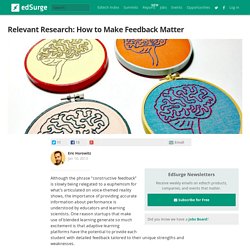
Although the phrase “constructive feedback” is slowly being relegated to a euphemism for what’s articulated on voice-themed reality shows, the importance of providing accurate information about performance is understood by educators and learning scientists. One reason startups that make use of blended learning generate so much excitement is that adaptive learning platforms have the potential to provide each student with detailed feedback tailored to their unique strengths and weaknesses. Yet exactly what kind of feedback -- including the level of detail, tone, and timing -- is most influential, is the subject of much research.
For example, while researchers have established that it’s important for feedback on a problem to contain the correct answer, they’ve failed to conclusively show that further elaboration is beneficial. The Power of Feedback. Abstract Feedback is one of the most powerful influences on learning and achievement, but this impact can be either positive or negative.

Its power is frequently mentioned in articles about learning and teaching, but surprisingly few recent studies have systematically investigated its meaning. This article provides a conceptual analysis of feedback and reviews the evidence related to its impact on learning and achievement. Untitled. Susanne Schulé.

Das 360-Grad-Feedback in der Führungskräfteentwicklung. Beispiel für ein gelungenes Feedback-Gespräch - Kritikgespräch. Der folgende Dialog zeigt, wie das Gespräch zwischen Frau Mohn und Herrn Ludwig aussieht, wenn dieser auf einen Wutanfall verzichtet und stattdessen konstruktive Kritik übt.

Herr Ludwig (freundlich): Frau Mohn, ich würde gerne mit Ihnen sprechen. Beispiel für ein gelungenes Feedback-Gespräch - Kritikgespräch. Feedback richtig geben: Die fünf wichtigsten Strategien. 1. So geben Sie Ihren Mitarbeitern wirkungsvoll Feedback! » Bernd Geropp Consulting. Feedback geben ist nicht einfach! Photo: auremar/ Quelle: www.bigstock.com Wenn es um Mitarbeiterführung geht, halten sich viele Manager immer noch an das schwäbische Sprichwort: „Nicht geschimpft ist genug gelobt“ Dieser Ausspruch entspricht der schwäbischen Sparsamkeit. Schließlich spart man sich das Lob.
Der Engelskreis des Feedbacks: Feedback und Rhetorik Tricks. „Das hast Du super gemacht! “ wird im Arbeitsalltag selten gehört. Viel wahrscheinlicher sind heute nur noch Stimmungstöter wie „Der Entwurf gehört in die Tonne! Feedback geben: Feedbackmethoden, Regeln beim Feedback geben. Untitled. Ich weiß nicht, was ich gesagt habe, bevor ich die Antwort meines Gegenüber gehört habe. Paul Watzlawick Sozialpsychologen um Kurt Lewin hielten Seminare ab, in denen Lehrer, Sozialarbeiter und Geschäftsleute die Anwendung eines neuen Gesetzes lernen sollten.
Die Trainer und Forschungsbeobachter trafen sich am Abend eines jeden Seminartages, wobei das beobachtete Verhalten des Leiters, der Mitglieder und der Gruppe analysiert, interpretiert und auf Tonband aufgenommen werden sollten. Bald kamen alle Teilnehmer zu diesen Sitzungen, da sie merkten, dass sie daraus wichtige Einsichten in ihr eigenes Verhalten und das ihrer Gruppe gewannen. Über uns - Keramikstadel - Rettenberg, Lagerverkauf, Pflanztöpfe, Keramik und Feinsteinzeug, Terracotta, Zinkgefäße, Artstone, Artclay, Bodenvasen, Polystone, Terrazo, Sandstein, Betonstein, Außenkeramik, Innenkeramik, Vasen. Was finden Sie bei uns? Professional Learning Community Definition. A professional learning community, or PLC, is a group of educators that meets regularly, shares expertise, and works collaboratively to improve teaching skills and the academic performance of students. The term is also applied to schools or teaching faculties that use small-group collaboration as a form of professional development.
Shirley Hord, an expert on school leadership, came up with perhaps the most efficient description of the strategy: “The three words explain the concept: Professionals coming together in a group—a community—to learn.” Professional learning communities tend serve to two broad purposes: (1) improving the skills and knowledge of educators through collaborative study, expertise exchange, and professional dialogue, and (2) improving the educational aspirations, achievement, and attainment of students through stronger leadership and teaching.
In professional learning communities, teams are often built around shared roles or responsibilities. Reform. Five Dysfunctions of a Professional Learning Community. Five Dysfunctions of a Professional Learning Community. What Is a Professional Learning Community (PLC)? "The very essence of a learning community is a focus on and a commitment to the learning of each student. When a school or district functions as a PLC, educators within the organization embrace high levels of learning for all students as both the reason the organization exists and the fundamental responsibility of those who work within it. " —Rick DuFour, Bob Eaker, and Becky DuFour (2007) From Isolation to Collaboration As I have watched teachers and administrators make the shift from teaching in isolation to operating as a collaborative team, I have witnessed several commonalities across schools.
All Teams Are Potentially Dysfunctional.